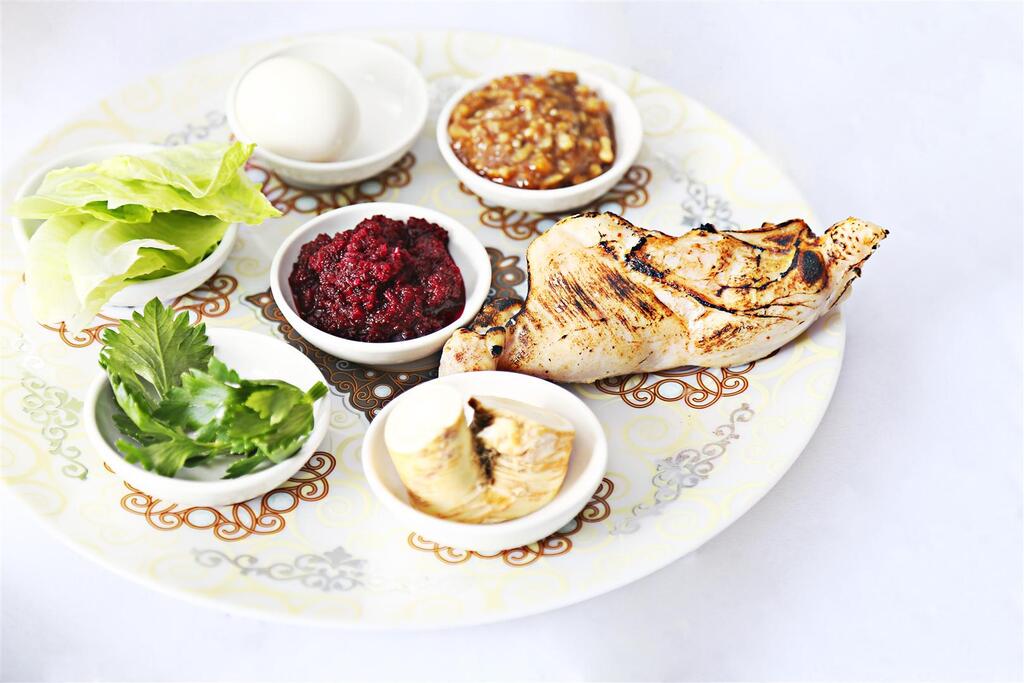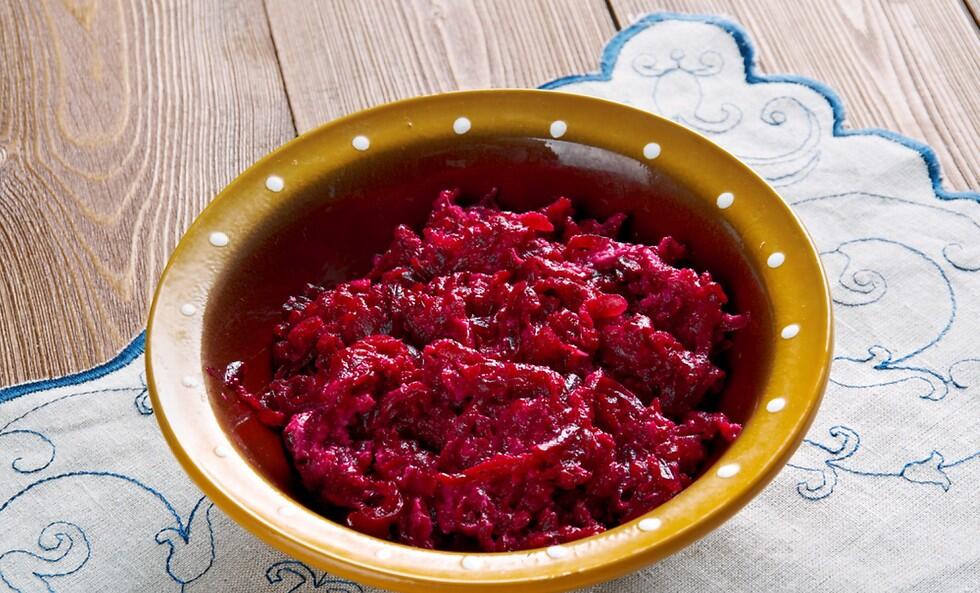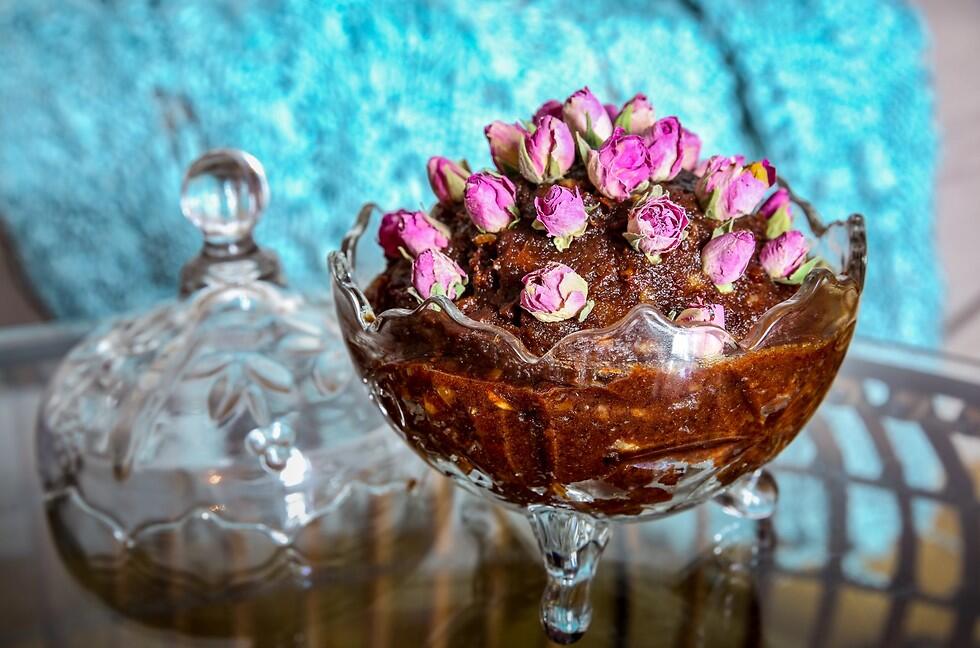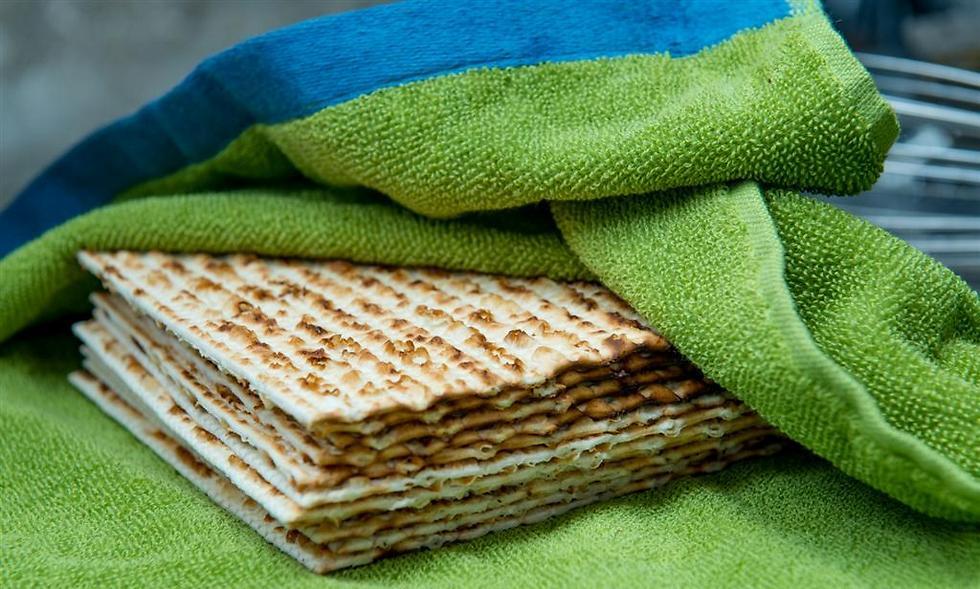Getting your Trinity Audio player ready...
Passover on a plate
On the evening of the Passover seder, just before eagerly diving into the meal, participants in the holiday ritual bless and eat some of the food items found on the traditional seder plate — a round dish placed at the center of the table, containing the six symbolic foods of the holiday: matzah, maror (bitter herbs), karpas (vegetable), charoset, meat and an egg.
To make things easier for you, we’ve prepared a detailed guide to the foods that should be on the plate, including recipes with a twist for those who want to add some excitement to the table.
Maror (Bitter herbs)
Maror symbolizes the bitterness of slavery. Typically, it consists of lettuce or bitter greens, alongside horseradish — either the grated white root or horseradish mixed with beets. Instead of lettuce leaves, you can prepare a fresh and tasty lettuce and an endive salad, which can serve as both the blessing and as a starter or side dish for the meal. Alternatively, you can choose any other green, refreshing salad.
Horseradish with beets
Ingredients:
- 150-200 grams (approximately 5-7 ounces) horseradish root
- juice of half a lemon
- ½ teaspoon salt
- 1 flat teaspoon sugar
For spicy red horseradish:
- 150-200 grams (5-7 ounces) horseradish root
- 2 medium-sized beets, cooked with their skin
- ½ teaspoon salt
- 1 flat tablespoon sugar
- ¼ cup simple vinegar (e.g., synthetic vinegar)
Preparation:
- Peel and grate the horseradish root.
- For red horseradish, peel and grate the beets as well. Strain the excess liquid.
- Mix everything together and store in a tightly sealed container in the fridge. After an hour, taste and adjust the seasoning if needed.
Karpas (Vegetable)
What exactly is karpas? It is a vegetable eaten at the beginning of the seder meal. While bread is traditionally eaten at the start of a regular meal (with the “Hamotzi” blessing), during the seder, karpas is eaten to break away from the usual order. According to tradition, eating the vegetable is intended to spark curiosity among the children at the table and encourage them to ask questions. After eating the karpas, the "Ma Nishtana" (Why is this night different?) is recited, usually by the youngest at the table, and the seder leader or the adults at the table tell the story of the Exodus from Egypt.
You can place celery stalks or pieces of potato on the table to serve as karpas for the blessing. However, you can also add a creative twist — incorporate the celery into a refreshing herb salad or substitute it with blanched, seasoned asparagus stalks. Let your imagination run wild!
Herb salad with celery
Ingredients for salad:
- 500 grams (1 pound) large celery roots (peeled weight)
- juice of half a lemon
- 2 teaspoons mustard
- 2-3 tablespoons mayonnaise (adjust to taste)
- salt and pepper
Ingredients for vinaigrette dressing:
- ½ cup olive oil
- 2 tablespoons wine vinegar or lemon juice
- 1 teaspoon mustard
- salt and pepper
Preparation:
- Peel and slice the celery into thin slices, then cut into thin matchsticks (or use a food processor to shred into fine strips).
- Soak the strips in a bowl of water seasoned with lemon juice for about an hour. Drain well.
- Prepare the vinaigrette: Combine all the dressing ingredients in a jar and shake well.
- Toss the drained celery strips with the vinaigrette.
- Before serving, mix the mayonnaise with mustard and add it to the salad.
Charoset (Symbolizing mortar)
Charoset symbolizes the hard labor of the Israelites in Egypt. It is traditionally used to dip the maror. Each Jewish community has its own version of charoset, and every family often has a favorite recipe. In Ashkenazi cuisine, charoset is usually made with apples, nuts, red wine and spices, while in Sephardi kitchens it often consists of dates and nuts.
Classic charoset
Ingredients:
- 10 large, pitted dates
- 1 Granny Smith apple, peeled and quartered, core removed
- 100 grams (3.5 ounces) walnuts
- 50 grams (1.7 ounces) hazelnuts
- ¼ cup sweet wine
- 4 tablespoons silan (date syrup)
- a pinch of cinnamon
- a pinch of clove
Preparation:
- Place all ingredients in a food processor and blend until smooth.
- Transfer to a bowl and serve.
Matzah
What more is there to say about matzah? You can place three matzot in the center of the table and point to them while you are leading your seder, but why not get creative and prepare a delicious appetizer using matzah? Try making a fattoush salad with pieces of dry matzah instead of bread. Or, take it a step further and make luxurious, festive matzah pancakes.
Get the Ynetnews app on your smartphone: Google Play: https://bit.ly/4eJ37pE | Apple App Store: https://bit.ly/3ZL7iNv
Festive matzah pancakes
Ingredients (for 8 pancakes):
- 4 tablespoons buckwheat flour
- 4 tablespoons matzah meal
- 1 cup almond milk (or regular milk for a morning version)
- 3 tablespoons oil (or melted butter) + 2 teaspoons for greasing the pan
- ¼ nutmeg, grated
- 2 eggs
- ½ teaspoon baking powder
- 1 teaspoon fine salt
- ½ bunch chives, chopped
For caramelized onions:
- 2 purple onions, thinly sliced
- 2 tablespoons olive oil
- ½ teaspoon fine salt
Preparation:
- Heat olive oil in a small pan over high heat. add the onion slices and fry until golden. add salt and set aside.
- Combine the dry ingredients in one bowl and the wet ingredients in another. gradually mix the dry into the wet with a whisk until smooth.
- Heat a pancake pan and grease it lightly.
- When the pan is hot, drop a heaping tablespoon of batter into each cavity. fry for one minute on one side, flip, and fry for two more minutes. remove and cover with a cloth.
- Top each pancake with a teaspoon of caramelized onion, drizzle with olive oil, garnish with a dill leaf, and serve hot.
The two cooked dishes
Our sages debated the meaning of the “two cooked dishes” mentioned in the Mishnah, which are required for the seder. Today, it is customary to serve two items — a dish with meat (symbolizing the Passover sacrifice) and an egg.
The zeroa (shank bone)
The original blessing is for a lamb shank, but if you’re not strict about tradition, you can use other cuts, such as head meat. For a more creative approach, you can opt for cold cuts like tongue, carpaccio or roast beef.
The egg
Yes, you can simply place a hard-boiled egg on the plate, but why not add a delicious twist? Consider egg salad, stuffed eggs or even a poached egg served on asparagus.
Carpaccio recipe
Ingredients (for 6 servings):
- 500 grams (1 pound) beef (fillet or sirloin), sliced into carpaccio (ask your butcher)
- 1 tablespoon capers (optional), chopped
- ½ bunch of arugula, washed
- juice of ½ lemon
- quality olive oil
- Atlantic sea salt
- freshly ground black pepper
Preparation:
- Arrange the carpaccio slices on a large plate. lightly salt them.
- Sprinkle the capers and place the arugula in the center of the plate. drizzle lemon juice over the arugula only, so it doesn’t marinate the meat.
- Generously drizzle olive oil over everything, grind black pepper on top, and serve.
This guide offers creative twists to elevate your seder plate, blending tradition with fresh ideas that will make your Passover meal both meaningful and delicious.
First published: 01:30, 03.27.25






